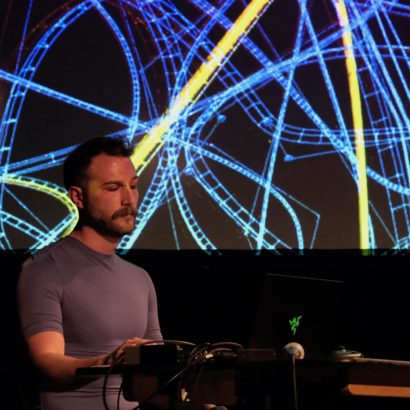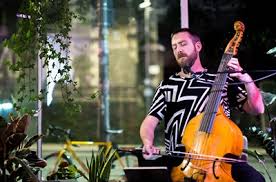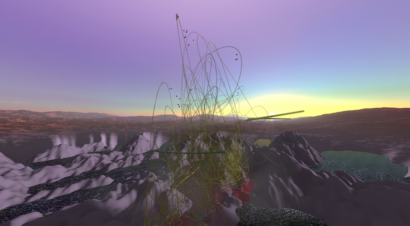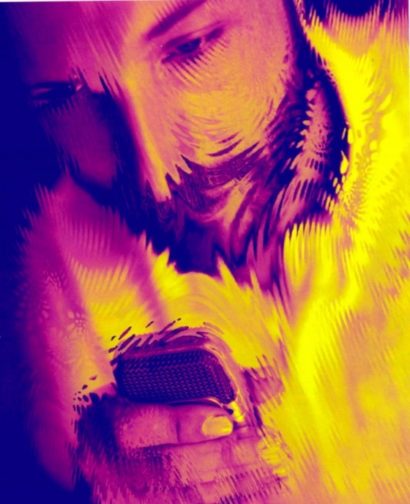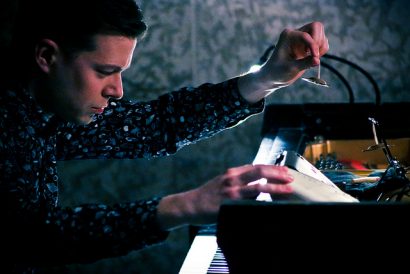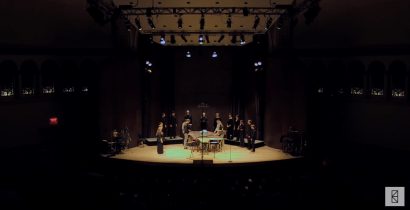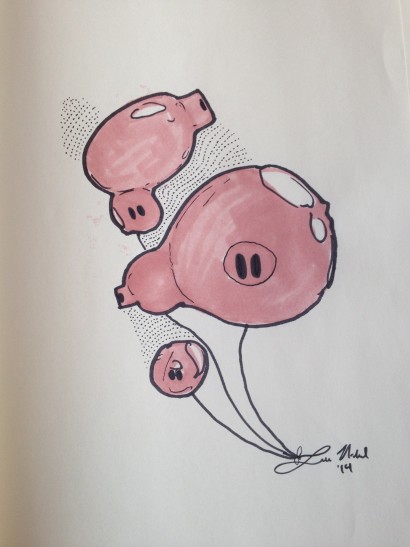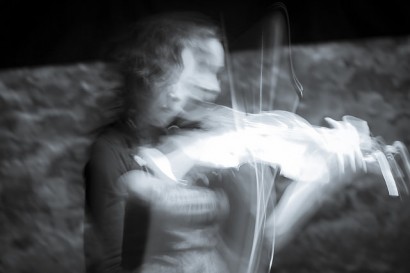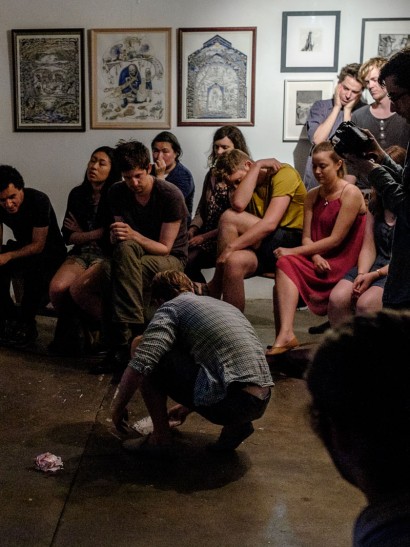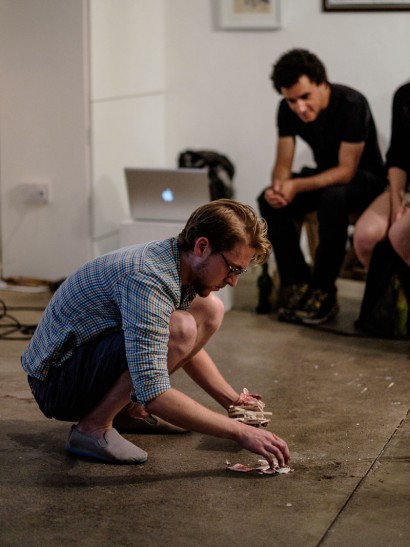Living Score
Steel Becomes Silk, Gravity Recast
Living Score
Juliet Fraser, simulated roller coasters, video, electronic sound
15:00
2020
Created for Juliet Fraser
About
This is a roller coaster. It looms, it arches, it curls and twists…
This is a roller coaster project by multidisciplinary artist Luke Nickel and soprano Juliet Fraser, a 15-minute performance combining voice and simulated roller coasters commissioned by Huddersfield Contemporary Music Festival for performance in November 2021. In this collaborative piece, Juliet and Luke transform roller coasters into sound through a process of simulated gravitational witchcraft.
The piece is built through a process of conversation and experimentation. Juliet has created a roller coaster in her mind, and has sung its tracks, its speed, its height and its G-force. Luke has been constructing simulated roller coasters in a digital space, and has collaborated with A.I. to write a witchy spell. Nothing is notated. The emerging piece has a living score, embodied in the mind and the muscle memory.
In the performance, Juliet and Luke face each other on stage. Juliet sings an unearthly, timeless music born of crests, hills and loops. From a laptop, Luke creates a mesmerising digital landscape of writhing simulated roller coasters that are projected beyond the performers for all to see. A strange incantation — co-written with an artificial intelligence module (GPT-2) — describes a roller coaster, gives voice to the roller coaster, transforms itself and the listener into a roller coaster.
…Steel becomes hair and fingernails, joining with muscles and tendons, animal and human and metal…
Performances
- Nov 2021, Huddersfield Contemporary Music Festival: https://hcmf.co.uk/programme/hcmf-shorts-3/
Acknowledgements
Palace64 was created with the generous support of the Manitoba Arts Council. The roller coaster was created using NoLimits 2,
Cousins
living score
created for Liam Byrne (viola da gamba) and Émilie Girard-Charest (cello)
2019
About
Cousins highlights the contested lineage and relationship of the viola da gamba and the cello. The piece was created using the same orally transmitted instructions for both soloists. Each realization is unique despite carrying the same DNA.
Performances
- October 28, 2019, Buenos Aires, Émilie Girard-Charest (cello)
- October 12, 2019, Bristol, Cousins, Liam Byrne (viola da gamba)
Other Documentation
Liam Byrne performs Cousins
Palace64
Living Score
Unspecified Chamber Ensemble
8:00
2019
Created for Decibel New Music
About
In Palace64, I wanted to explore algorithmic roller coaster building. I created 20+ roller coasters using various formulae, which I imported as paths to Nolimits Coaster. Then, I created a custom 3D environment and shot countless hours of video, which I edited into what you see above! I wanted to evoke the idea of a post-human roller coaster environment reminiscent of a coral reef on an alien planet.
Musically, the piece consists of a pre-recorded track made up of a stretched out field recording taken at Thorpe Park as well as live acoustic instruments. I transmitted this piece to Decibel orally using a series of recorded spoken transmissions. During the performance, the musicians react to both the impossible virtual roller coasters on screen and mental and embodied memories of roller coasters—both real and imagined.
Performances
- July 25, 2019 by Decibel New Music at Monash University at TENOR2019 in Melbourne, Australia
Further Information
Acknowledgements
Palace64 was created with the generous support of the Canada Council for the Arts. The roller coaster was created using NoLimits 2, and the video was edited in Adobe Premiere Pro. Special thanks to Cat Hope.
A Hushed Workshop
Living Score
Solo Instrument
Open Duration
2018
Created for Heather Roche
About
A Hushed Workshop was created in collaboration with Heather Roche during Autumn 2019. The piece centres around the oral transmission of descriptions of numerous conceptual machines inside an imaginary workshop. Roche wrote an article about the piece that was featured in Musicworks Issue 132, and a few phrases can be found below:
Luke Nickel has left me a series of sometimes vague, sometimes specific instructions via audio recordings of his voice, which I am only allowed to listen to once, so that I may create a piece… By relying on the creative imagination and memory of the performers he works with, Nickel’s work embodies an ideal form of performer-composer collaboration… He puts an enormous amount of trust in the performers of his music… Luke’s voice is calm as he explains how the process will unfold. His voice is relaxing to listen to, and it already feels like the process of creating the piece will be something for just us, something rather intimate.”
The following recording was recorded by Simon Reynell of the Another Timbre label at the Music Room in South London, and it first appeared in Musicworks Issue 132. Photo credits go to Sam Walton.
Performances
A Hushed Workshop has not been premiered yet—if you’re interested in booking a performance, please contact Heather Roche or myself.
Acknowledgments
I acknowledge the support of the Canada Council for the Arts.
Oshima
Living Score
Solo Piano
Open Duration
2017
Commissioned by Everett Hopfner
About
Oshima, which Hopfner learned in a series of late-night radio transmissions, sonically sketches a character from Murakami’s Kafka on the Shore in a sparse deconstruction of jazz and darkness.
Performances
March 12, 2017, Cluster: New Music + Integrated Arts Festival by Everett Hopfner (Winnipeg, MB)
Other Documentation
Full performance recording live from Cluster Festival
who’s exploiting who
Living Score
Chamber Ensemble
Open Duration
2016
Commissioned by the Thin Edge New Music Collective
About
I developed Who’s Exploiting Who collaboratively with the Thin Edge New Music Collective in January and February 2016. There is no written score for the piece, and as a result it relies entirely on the ensemble’s collective memory to be realized.
Before each TENMC rehearsal, I corresponded individually with every member of the ensemble via a temporary audio file that I posted privately on soundcloud. These correspondences contained recordings of my voice describing musical parameters, metaphorical text and logistical instructions. During rehearsals, the ensemble patched together a collective understanding of the piece based on their individual memories of the original correspondences. I was not present for rehearsals, thus allowing the resulting constellations of their new insights to supersede my original artistic impulses.
Who’s Exploiting Who is based on one of my favourite songs released in 2015 — Exploitation by Roísin Murphy. I fed various musical fragments of the original song through my somewhat scattered memory as well as the (less scattered) memory of the TENMC. The result is (hopefully!) a kaleidoscopic and hallucinogenic exploration of complete musical obsession.
Roísin seems to like the arrangement…
Performances
- February 16, 2016 at ArrayMusic by the Thin Edge New Music Collective (Toronto, ON)
smokescreen
Living Score
SATB Choir + Percussion
Open Duration (c.a. 10 minutes)
2016
Commissioned by Architek Percussion and Viva Voce
About
Smokescreen is an orally-transmitted piece created in collaboration with Architek Percussion and Viva Voce in Montreal.
To create the piece, I used a late 14th century work by Solage (fumeaux fume par fumée) as the source material. This mysterious and beautiful motet is stretched into glacially slow intervals punctuated by hazy static and shimmering choral resonances (how’s that for a program note!)
Performances
- January 17, 2016 at Salle Bourgie, Architek Percussion and Viva Voce, Directed by Peter Schubert (Montreal, QC)
- April 4, 2016 at Sala Rossa, Architek Percussion (Montreal QC)
Acknowledgements
I acknowledge the support of the Canada Council for the Arts.
the strange eating habits of Erik Satie
Living Score
SATB Choir
Open Duration (c.a. 10 minutes)
2014-2015
Commissioned by EXAUDI
About
I developed The Strange Eating Habits of Erik Satie collaboratively with James Weeks and the EXAUDI vocal ensemble in London, UK as a part of Sound and Music’s Portfolio scheme. The piece was created in several meetings occurring over the course of a year (2014-2015). There is no written score for the piece, and as a result it relies entirely on the ensemble’s collective memory to be realized.
Before each meeting, I corresponded individually with every member of the ensemble via a temporary audio file that I posted privately on soundcloud. These correspondences contained recordings of my voice describing musical parameters, metaphorical text and logistical instructions. During rehearsals, the ensemble patched together a collective understanding of the piece based on their individual memories of the original correspondences. I silently watched, often allowing the resulting constellations of their new insights to supersede my original artistic impulses.
The manner in which the piece transforms and decays continually over time is reflected in my musical dismantling of the work’s source material: Erik Satie’s Choral Inappetissant from his Sports and Divertissements (originally written for piano).
Performances
- October 17, 2015 by EXAUDI (London, UK)
Acknowledgements
I would like to acknowledge the support of Sound and Music in the creation of this work.
[Factory]
Living Score
Open Instrumentation
Open Duration
2014
Commissioned by Mira Benjamin
About
[factory] originated as a set of 22 verbal scores linked by a geographical map, with each score representing an individual conceptual area or room. Mira Benjamin, the original performer, and I agreed upon a risky proposal: she would read the scores only once and then delete them, allowing the work to exist solely in her memory and inviting forgettings and linguistic permutations to infect the ephemeral score-object itself. Mira is now the living score for the work, voluntarily responsible for its transferral, transformation and translation.
Performances
- March 2014, Mira Benjamin, Cluster: New Music + Integrated Arts Festival, Winnipeg, MB
- May 2014, Mira Benjamin, Oslo, Norway
- August 2014, Mira Benjamin and Isaiah Ceccarelli, nu:nord, Oslo, Norway
- August 2014, Mira Benjamin and Isaiah Ceccarelli, London, UK
- January 2015, Michael Baldwin, Huddersfield, UK
- June 2015, Mira Benjamin, Music and/as Process Conference, London, UK
- July 2015, Michael Baldwin, Hundred Years Gallery, London, UK
Other Documentation
- photo (c) Dimitri Djuric
- photo (c) Dimitri Djuric
Writing
The following is an excerpt from an interview between Jennie Gottschalk and Mira Benjamin. This interview has been excerpted in Gottschalk’s Experimental Music Since 1970.
JG: So I wanted to talk about the process around these pieces… about the transmission of scores, what possibilities there are for an experiment to take place in that activity, at that intersection.
MB: Luke uses the term “accessing” – someone who wants to know [factory] must access an archive of sorts.
JG: So you’re the archive?
MB: I’m a living score – one of six or so people who house Luke’s various pieces. The only currently active living score, I believe.
JG: Is your memory the score of [factory], or you yourself?
MB: That distinction is not really made. My relationship and dialogue with my own memory is an essential part of the process of actualizing these pieces. It is inevitable in this process that I will forget and unintentionally ‘rewrite’ certain elements, and that each act of relaying a piece will feed back into my own memory. The original artifact of [factory] will degrade and this is the creative, transformative process that is opened by this approach. This process is all about contamination.
JG: Would it be in keeping with the spirit of the project to actually ask you to relay a piece [factory] to me now?
MB: If I started telling it to you now, your interview would just be full of “redacted”s! *laughs* To allow memory to take priority in this process, I can only transmit pieces during a dedicated accessing session, and they can’t be written down or transcribed.
Some thoughts from Michael Baldwin as well as a short video of [factory]
The following is an excerpt of an accessing session between Michael Baldwin and Mira Benjamin
MBa: Before we dive directly into this, I’m curious to know what the bounds of the score are. So, for example, in our conversation today, at what point do you begin transmitting [factory]? Is it intermittent throughout the conversation or is there a moment at which it is delivered?
MBe: This entire conversation is the score for [factory]. Everything we talk about contributes to it. When I actualise [factory], I base the performance on my memory of Luke’s texts in combination with an understanding of the mentality of the project. That’s why I was telling you about the map before.
MBa: Sorry, just so I’m clear, is this a part of [factory]?
MBe: Yeah, this is one of the rooms, it’s called [redacted] or [redacted]. So you’re in a situation where either you allow a memory to, or can’t stop a memory from, [redacted]. And it could be [redacted], or it also could [redacted]. Because of the conditions of the first room I gave you, I think it allows for that. And you just [redacted].
made of my mother’s cravings
Living Score
String Quartet
Open Duration
2014
made in collaboration with Quatuor Bozzini as a part of Composer’s Kitchen 2014
About
I created Made of My Mother’s Cravings in collaboration with the Bozzini String Quartet between June 2014 (Montreal) and November 2014 (Huddersfield). My goal for the project was to investigate the ways in which memory could be used as a process to transform not only musical material (as seen in works by Lucier, Fox, Saunders, and Walshe) but musical scores themselves.
I held private meetings with each member of the quartet, telling them different aspects of the work (pitch, form, affect, timbre, reactions, relationships, concepts, etc). Some information was to be shared with the group, while some was to be kept private. I asked the quartet not to record any of the conversations. The group then assembled the piece using their individual memories of the score, and performed the piece in Montreal. Six months passed by, and the group remounted the piece in Huddersfield, UK. Because there was no written or recorded score, the quartet had to play the piece from memory. Several extraordinary musical transformations occurred. The piece continues to exist solely in recorded artifacts (akin to documentary photos of performance art) and the memory of the performers.
Because living scores exist solely in my memory and the memories of the performers, generally re-performances are instigated by the same ensemble or musician (thus illustrating the transformation of the piece over time). However, living scores can be made transferable either via temporary audio recordings of spoken instructions (which expire after one view/listen) or surrogate conversationalists (as in a game of telephone). These methods ensure the living scores retain their essential ephemerality, which allows for their vibrant transformation over time in human memory.
Performances
- June 2014, Quatuor Bozzini (Montreal, QC)
- November 2014, Huddersfield Contemporary Music Festival, Quatuor Bozzini (Huddersfield, UK)
Other Documentation
Full recording found below:
